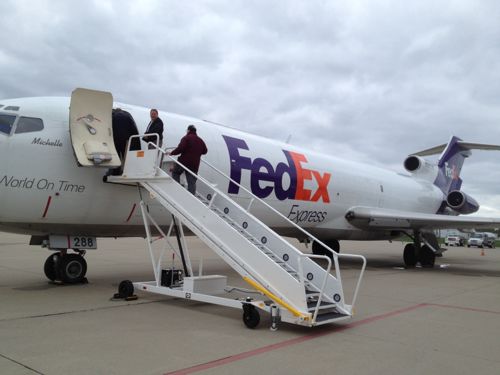Donated Boeing 727 To Help Train First Responders
As many of you know, Metro, formerly know as the Bi-State Development Agency, operates our MetroBus and MetroLink light rail service. Metro also runs the trams inside the Arch and operates the Saint Louis Downtown Airport (map). Although MetroBus service does reach the airport, my boyfriend drove me on April 19th to view Metro accepting a Boeing 727 from FedEx Express.

Here is the donated plane will be used:
Although the aircraft’s primary purpose will be to train firefighters and other emergency response force personnel, it will also serve as a classroom and a ground trainer for future pilots and aircraft maintenance technicians, and be made available to researchers and educators for use in their air safety and educational programs.
The pilots’ cockpit will remain intact, just as it is when the pilots stepped out of it, however, changes will be made throughout the rest of the aircraft. The front half of the fuselage will be configured as a standard passenger airliner, complete with a pull-down screen and overhead projector for use in classroom-style presentations to tour groups visiting the airport and the Greater St. Louis Air and Space Museum, and to youth flying with Experimental Aircraft Association (EAA) Chapter 64 in their Young Eagles program. Jet Aviation, which has a history of doing maintenance and repair work for the FedEx corporate fleet at its facilities at St. Louis Downtown Airport, will assist in preparing the aircraft for its new mission.
The rear half of the fuselage will be outfitted to contain a maze of hanging hoses, wires, and other obstructions with cargo containers, boxes, and jumbled seats. During training sessions, non-toxic smoke generators will fill the aircraft with smoke as if the aircraft had made a crash landing. Area firefighters will be able to don their gear and enter the aircraft to search for survivors and complete a myriad of real-world training scenarios. (source)
Firefighters in the region currently get trained in simulated spaces, not with actual aircraft. Once ready for training, firefighters from the region will be able to come practice maneuvers in a more realistic setting.
This plane has a brief St. Louis history:
The aircraft was delivered on October 25, 1979, in full Ozark Airlines’ colors, however, it was transferred to Pan American World Airways that same day. Pan Am operated it as “Clipper Frankfurt” from Oct. 25, 1979, until they ceased operations on Dec. 4, 1991. The aircraft was placed in storage from Dec. 5, 1991, until it was acquired by FedEx Express on April 22, 1993.
Ozark Airlines operated from Lambert until merging with TWA.
— Steve Patterson
Well I think it will be a great learning tool, help me understand why Metro took possession of it. Fire departments yes, but Metro?
Metro / Bi-State owns the airport where it will be located.
thanks for clarifying. Maybe that’s part of Metro’s problem….running the Arch Trams and managing an airport could be interpreted as non-core businesses. Just a thought.
From Metro’s website:
“In existence for more than 60 years, Metro Transit is one of the nation’s oldest interstate agencies. However, it hasn’t always been known as Metro Transit.
It was established as the Bi-State Development Agency (BSDA) in 1949 through an interstate compact between Missouri and Illinois, ratified by the U.S. Congress and signed by President Harry S. Truman. (The BSDA adopted the name Metro in 2003.) The BSDA was created to serve the region on both sides of the Mississippi – to have a regional outlook not tied to any one municipality, county or state. As such, it was given broad powers that enable it to cross local, county and state boundaries to enhance the development of the region.
Although the Agency is now best known for its transit system, it would be 14 years – in 1963 – before it operated a public transit vehicle. In fact, during its first year of operation, the BSDA:
– Commissioned a comprehensive plan for development of the Missouri-Illinois Metropolitan District, outlining the major needs of the area and recommending solutions.
– Sponsored a study of the pollution in the Mississippi River in the St. Louis area. This led to a successful program where local industries voluntarily agreed to treat wastes in order to reduce pollution.
– Completed a study of the sewer problems of St. Louis County, which led to the establishment of the Metropolitan Sewer District.
– Sponsored an area-wide survey of highways and expressways in Missouri and Illinois – one of the first instances of coordinated interstate highway planning.”
Source: http://www.metrostlouis.org/About/History.aspx
I get all that Steve. I remember when they went from BiState (going your way) to Metro. But as with any business….sooner or later it helps to re-evaluate what their core business is. Just because Metro did some other things in the past, doesn’t mean it need/should continue to do so. You see Fortune 500 companies buying different types of businesses with hopes to expand and then sooner or later, they re-evaluate to see what still fits. Don’t get me wrong, I’m not saying it’s right or wrong, just “could be” and that maybe re-evaluation time is in order.
From a historic perspective, it would be pretty cool if it were (re)painted “in full Ozark Airlines’ colors”!